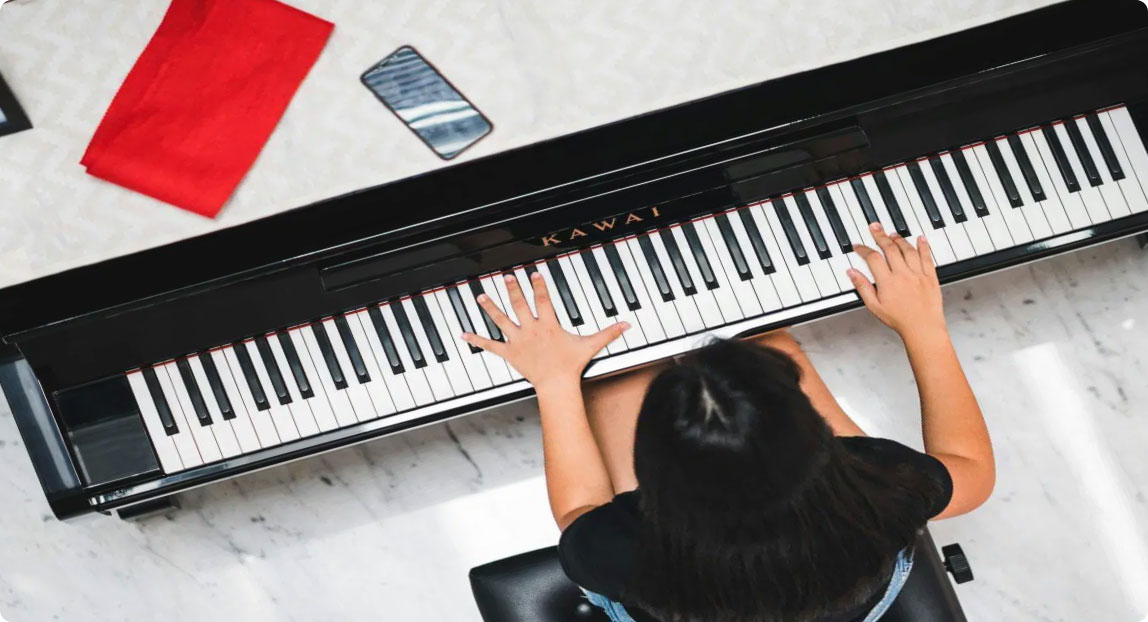
PLAY THE Piano
Master THE ART
The clarinet, with its unique single-reed design, boasts a rich sound palette that ranges from resonant low notes to brilliant high pitches, making it a favourite across various musical genres, from classical symphonies to jazz bands. Our clarinet lessons are crafted to celebrate this versatility while guiding students towards musical mastery.
Understanding and achieving the correct posture is vital for any clarinetist. Given the clarinet’s specific weight distribution, we place significant emphasis on instructing students to maintain a balanced and ergonomic posture. This not only ensures comfortable play but also facilitates optimal sound projection.
Mastering a proper embouchure is at the heart of playing the clarinet. The instrument’s reed and mouthpiece design necessitate precise lip positioning and pressure. Our seasoned instructors offer targeted exercises and invaluable feedback to assist students in honing their embouchure, guaranteeing pure, uninterrupted tones.
Breath control is another fundamental aspect of clarinet playing. With its cylindrical bore and closed-key system, the clarinet demands controlled and consistent airflow. Through our lessons, students engage in focused breathing exercises, enhancing their ability to produce sustained and expressive musical phrases.
When it comes to tone production, the clarinet stands out with its wide dynamic range and ability to shift seamlessly between registers. Our educators guide learners in understanding the techniques behind producing various tones, from the deep, mellow chalumeau register to the bright and agile clarion and altissimo registers.
Central to all these teachings is the technique — the rapid finger transitions, precise articulations, and the smooth glissandos that characterize advanced clarinet playing. Our comprehensive curriculum covers all facets, from foundational skills to advanced methodologies, enabling students to truly resonate with the clarinet’s potential.
The clarinet’s distinct characteristics — its capability to produce both velvety, lyrical melodies and swift, rhythmic passages — position it as an instrument of deep emotional depth. Unveil the beauty and potential of the clarinet with our lessons, allowing its sounds to touch your soul and express your innermost feelings.

OUR Promise
-

dedicated & passionate
-

strong foundation
-

result driven
STUDENT’S Journey


BOOK A Consultation
FREQUENTLY ASKEDQuestions
The cost of music lessons in Singapore can vary depending on the type and level of instruction. Private music lessons tend to be more expensive than group classes, as they offer more personalised instruction.
The price of music lessons also depends on the teacher’s qualifications and experience, as well as the type of music being taught.
In general, music lessons in Singapore can range from $50 per hour for basic instruction to over $100 per hour for advanced or specialised classes.
Singapore is home to many music schools, offering a wide range of music-related courses and programs.
According to statistics from the Ministry of Education, there are over 260 music schools in the country. These schools provide music education at all levels, from beginner classes for young children to advanced music theory and composition classes for adults.
Music schools in Singapore offer lessons in a variety of music genres, including classical music, jazz, pop music, and traditional music. Students can gain practical experience by participating in concerts or recitals held at the schools.
Learning piano in Singapore can be a rewarding experience and is an excellent way to pursue music. The cost of piano lessons varies depending on factors such as the teacher’s qualifications, location, and frequency of lessons.
Generally speaking, piano lessons in Singapore usually range from $50 to $200 per hour.
Those seeking more experienced teachers may pay a premium for lessons, but overall, piano lessons in Singapore are relatively affordable.
Music classes can be a great way for children to develop their musical skills and explore the world of musical instruments in a safe and educational environment.
Music classes can also improve concentration, collaboration skills, and self-confidence, as well as teaching music theory and providing exposure to different styles of music.
Additionally, music has been proven to have a positive effect on the brain and help with memory retention. Participating in music classes can provide numerous benefits for children and support their overall development.
When it comes to taking music classes, there is no single “best” age to learn. Ultimately, the best time to learn music depends on a variety of factors such as individual learning styles and abilities, availability of resources, and commitment level.
For younger children, around ages 3-6 may be an ideal age to learn music as they are developing their auditory and motor skills, which makes it easier for them to learn and remember. At this age, children tend to have more free time and energy to take on a new skill like learning an instrument.
The amount of time it takes to learn music depends on several factors, including the type of music you are learning and your individual abilities.
If you have prior experience with a musical instrument or knowledge of music theory, it can take less time to learn than someone who is starting from scratch.
Generally speaking, it can take anywhere from six months to a year to learn the basics of playing a musical instrument and reading basic music notation. After that, it may take years to learn more advanced techniques or become proficient in a specific style of music.
With dedication and practice, you can learn to play music in whatever amount of time is right for you.
Piano lessons can be a great way to develop your piano-playing skills and musical understanding. They provide an opportunity to work with experienced piano teachers who can help you progress in the best possible way.
Not only will they teach you proper piano technique, but piano lessons can also open up new musical possibilities and help bring out your creative side.



